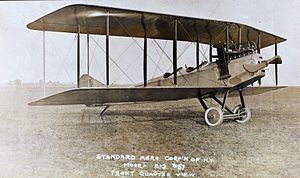 | ||
Manufacturer | ||
The Standard H-2 was an early American Army reconnaissance aircraft, ordered in 1916.
Contents
The Standard H-2 was built by the Standard Aircraft Corporation, and previously known as the Sloane H-2. It was an open-cockpit three-place tractor biplane, powered by a 125 hp (90 kW) Hall-Scott A-5 engine. Only three were built.
An improved version, the H-3, with the same engine, earned an order for nine aircraft, while the Navy ordered three with floats as the H-4H.
Two Standard H-3s were sold by the US Army to Japan, where a further three were built by the Provisional Military Balloon Research Association (PMBRA) in 1917, powered by 150 hp (110 kW) Hall-Scott L-4 engines. They were used as trainers between May 1917 and March 1918, although they were considered dangerous.
Operators
Specifications (H-3)
Data from Couse in Aerodynamics and Airplane Design: Part II–Section 1
General characteristics
Performance
